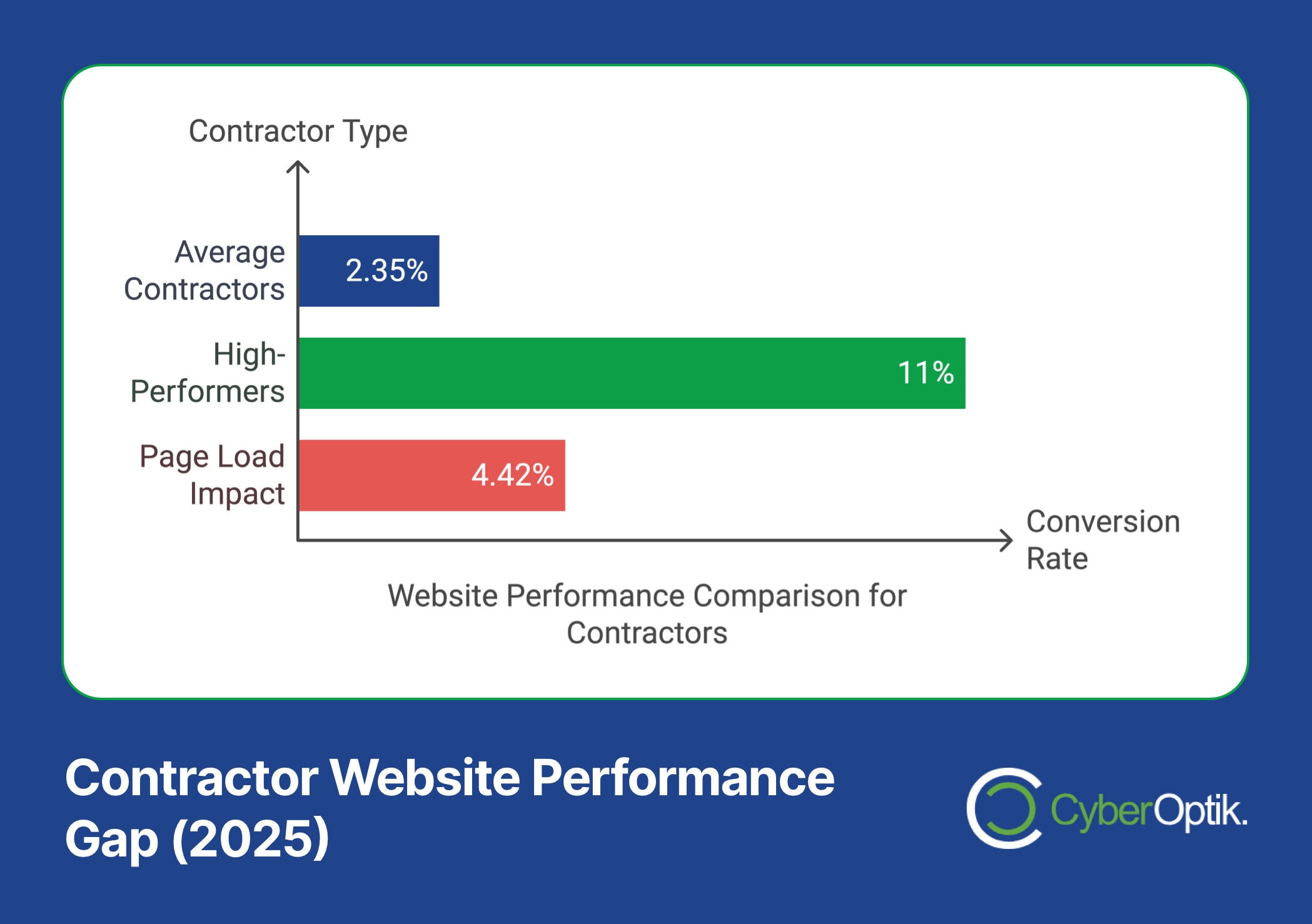Website conversion rates plummet by 4.42% for each second visitors wait for your page to load (Source: WordStream). For contractors, this translates directly to lost leads and missed opportunities.
We’ve analyzed hundreds of contractor websites and discovered a clear pattern: most aren’t built to convert visitors into customers. Our data shows that focusing on website conversion can transform your digital presence from a basic business card into a powerful lead generation engine.
This blueprint combines our proven strategies with the latest conversion optimization techniques for 2025. We’ll show you exactly how top-performing contractor websites generate leads consistently while building trust with potential clients.
The Current State of Contractor Websites in 2025

The construction industry faces a significant digital divide. While the average website conversion rate across industries stands at 2.35%, top-performing websites achieve rates of 11% or higher (Source: EcommerceBonsai). Our analysis of residential contractor websites reveals why this gap exists and how to bridge it.
| Website Element | Average Contractors | High-Performing Contractors |
|---|---|---|
| Mobile Responsiveness | Basic adaptation | Full mobile optimization |
| Page Load Speed | 5+ seconds | Under 2 seconds |
| Contact Options | Single contact form | Multiple conversion points |
| Portfolio Display | Static images | Interactive galleries |
We’re seeing three primary conversion bottlenecks across contractor websites. First, outdated designs that don’t reflect the quality of work being delivered. Second, poor mobile experiences that frustrate potential clients searching for services on their phones. Third, complicated quote request processes that create unnecessary friction in the customer journey.
The competitive landscape has shifted dramatically. Contractors who’ve invested in conversion optimization are capturing a disproportionate share of online leads. They’re achieving this through strategic implementation of user-friendly design, clear call-to-action placement, and streamlined contact processes.
Foundation: Essential Website Elements That Drive Conversions
Speed and Performance Optimization
Speed isn’t just about user experience—it’s about revenue. Websites loading in one second achieve conversion rates five times higher than those taking 10 seconds to load (Source: OpenAsset). Our experience with B2B website design shows that contractors must prioritize these technical optimizations:
- Image compression without quality loss
- Content Delivery Network (CDN) implementation
- Browser caching configuration
- Code minification and optimization
User Experience Design
We’ve identified specific user experience patterns that consistently drive higher conversion rates for contractors. The key is creating a clear path to conversion while showcasing your expertise:
Navigation must follow the three-click rule: visitors should find essential information within three clicks. Your service pages need prominent placement, and contact options should remain visible throughout the user journey. We’re seeing the most success with sticky headers containing click-to-call buttons for mobile users.
Trust-Building Elements

Trust signals differentiate high-converting contractor websites from their competitors. Strategic placement of these elements throughout your site reinforces credibility:
- License numbers and certifications above the fold
- Recent project galleries with before/after images
- Client testimonials with specific project details
- Industry association memberships
- Insurance and warranty information
The foundation of a converting contractor website combines technical excellence with strategic content placement. Each element must work together to build trust while making it effortless for potential clients to take action. This approach ensures your website serves as an effective sales tool, not just a digital brochure.
Conversion-Focused Design Strategies
Professional website design isn’t just about aesthetics—it can increase conversion rates by 95% when properly implemented. Our analysis of successful gutter cleaning websites reveals specific design elements that consistently drive leads.
Visual Elements That Convert
High-converting contractor websites leverage visual content strategically:
- Project photos with optimal compression for fast loading
- Video walkthroughs of completed projects
- Interactive before/after sliders
- Service process infographics
- Team photos that build trust
We’ve found that contractors who showcase their work through professional photography see significantly higher engagement rates. The key is balancing visual impact with performance—every image must serve a purpose in the conversion journey.
Content Structure for Maximum Impact
Your content structure determines how effectively visitors absorb information and take action. We implement these proven patterns:
| Page Type | Key Elements | Conversion Goal |
|---|---|---|
| Service Pages | Problem-solution format, clear pricing, immediate action options | Quote requests |
| Portfolio Pages | Filterable galleries, project details, client testimonials | Consultation bookings |
| Blog Content | Expert advice, maintenance tips, industry insights | Newsletter signups |
Each page must guide visitors toward specific actions while building confidence in your services. We structure content in scannable sections with clear hierarchies, ensuring important information stands out:
- Benefit-focused headlines
- Scannable bullet points for key features
- Strategic white space for better readability
- Multiple CTAs positioned at natural decision points
The most effective contractor websites maintain consistency across all design elements while adapting to user behavior patterns. This approach creates a seamless experience that naturally guides potential clients from interest to action.
Technical Optimization for Lead Generation
Technical optimization directly impacts conversion success. Websites incorporating user-generated content and optimization strategies see conversion rates jump from 3.2% to 7% (Source: WordStream). Our approach to website optimization focuses on two critical areas: form optimization and analytics implementation.
Form Optimization
Contact forms serve as your website’s primary conversion tool. We’ve identified these best practices for contractor quote forms:
- Maximum of 5 fields for initial contact
- Smart form logic that adapts to user inputs
- Auto-fill functionality for returning visitors
- Mobile-optimized input fields
- Clear error messaging and validation
The most successful contractor forms follow a progressive disclosure approach. Start with basic contact information, then gather project details through a structured follow-up process. This reduces initial friction while ensuring you receive qualified leads.
Analytics and Tracking
Effective conversion optimization requires precise tracking. Implement these essential analytics elements:
| Tracking Element | Purpose | Key Metrics |
|---|---|---|
| Goal Tracking | Measure form submissions and calls | Conversion rate, completion time |
| Heat Mapping | Understand user interaction patterns | Click distribution, scroll depth |
| Form Analytics | Identify form abandonment issues | Drop-off points, field time |
We recommend implementing A/B testing for critical elements:
- Call-to-action button text and colors
- Form field arrangements
- Landing page layouts
- Value proposition messaging
Technical optimization requires continuous monitoring and adjustment. By tracking user behavior and form performance, you can identify and eliminate conversion barriers while enhancing elements that drive results. This data-driven approach ensures your website consistently generates high-quality leads.
Implementation Roadmap
With average conversion rates ranging from 2% to 5%, and top performers exceeding 5% (Source: IdealRev), proper implementation timing is crucial. Our systematic approach to website maintenance and optimization ensures steady improvement without disrupting your existing lead flow.
Immediate Improvements (Week 1)
Speed optimization
- Image compression
- Cache configuration
- Server response time optimization
Mobile responsiveness fixes
- Viewport adjustments
- Touch target sizing
- Form field optimization
Critical conversion element updates
- CTA button visibility
- Contact information prominence
- Form field reduction
30-Day Optimization Plan
| Week | Focus Area | Expected Impact |
|---|---|---|
| Week 2 | Content restructuring and UX improvements | Enhanced user engagement |
| Week 3 | Trust signal integration and portfolio enhancement | Increased conversion confidence |
| Week 4 | Analytics setup and initial testing implementation | Data-driven optimization capability |
90-Day Growth Strategy
Long-term success requires systematic implementation of conversion optimization elements:
Month 2:
- A/B testing of key conversion elements
- User feedback collection and implementation
- Content expansion based on analytics data
Month 3:
- Advanced tracking implementation
- Conversion funnel optimization
- Personalization features deployment
This phased approach ensures each improvement builds upon previous successes while maintaining website stability. Regular performance reviews allow for quick adjustments based on real-world results, ensuring your website consistently moves toward optimal conversion rates.
Measuring and Improving Results
Successful contractor websites maintain bounce rates below 40% (Source: EcommerceBonsai). Through proper bounce rate analysis and performance tracking, you can continuously optimize your website’s conversion potential.
Key Performance Indicators (KPIs)
| Metric | Industry Benchmark | Target Goal | Measurement Frequency |
|---|---|---|---|
| Form Conversion Rate | 2-5% | 5%+ | Weekly |
| Phone Call Conversion | 1-3% | 3%+ | Weekly |
| Average Time on Site | 2-3 minutes | 4+ minutes | Monthly |
| Pages per Session | 2-3 pages | 3+ pages | Monthly |
Optimization Cycle
Follow this systematic approach to continuous improvement:
Weekly Analysis
- Conversion rate tracking
- Form completion rates
- Call tracking metrics
Monthly Review
- User behavior patterns
- Content performance
- Mobile vs desktop conversion comparison
Quarterly Assessment
- Overall conversion trends
- ROI calculation
- Competitive analysis
Success in website conversion optimization comes from consistent monitoring and strategic adjustments. Focus on these key areas for improvement:
- Page-specific conversion rates
- User flow optimization
- Form field performance
- Call-to-action effectiveness
- Mobile conversion parity
By maintaining a regular optimization schedule and responding to performance data, your contractor website can consistently outperform industry averages. Remember that optimization is an ongoing process—each improvement creates new opportunities for further enhancement.
Frequently Asked Questions
Based on our experience working with contractors, here are the most common questions about website conversion optimization, along with our expert answers.
How long does it take to see improvements in website conversion rates?
Initial improvements can be seen within the first 30 days after implementing basic optimizations like speed improvements and form simplification. However, significant and sustainable increases in conversion rates typically emerge over 90 days as we gather data and make informed adjustments. The key is consistent monitoring and optimization rather than expecting overnight results.
What’s the most important element for increasing contractor website conversions?
While multiple elements contribute to conversion success, clear and accessible contact options consistently prove most crucial. This includes prominently displayed phone numbers, simplified contact forms, and strategic placement of call-to-action buttons. These elements should be supported by proper website policies and trust signals to maximize effectiveness.
How much should I invest in website conversion optimization?
Investment should be based on your current lead value and volume. We recommend allocating 15-20% of your digital marketing budget to conversion optimization. This typically provides the best ROI, as even a 1% increase in conversion rate can significantly impact your bottom line when properly implemented.
Should I focus on mobile or desktop optimization first?
With most contractor searches now happening on mobile devices, we recommend prioritizing mobile optimization. However, this shouldn’t come at the expense of desktop functionality. The goal is to create a seamless experience across all devices while acknowledging that mobile users often have different needs and behaviors than desktop users.
How do I maintain high conversion rates after achieving them?
Maintaining high conversion rates requires:
- Regular performance monitoring
- Ongoing A/B testing of key elements
- Consistent content updates and improvements
- Regular user feedback collection and implementation
- Continuous competitive analysis
What role does content play in conversion optimization?
Quality content serves multiple conversion-focused purposes. It establishes expertise, addresses customer concerns, and guides visitors toward taking action. Focus on creating content that answers specific questions your potential clients have while naturally incorporating calls to action.
How do I know if my current conversion rate is good?
While industry averages provide a baseline, your specific conversion rate goals should be based on:
- Your service area size
- Average project value
- Current lead closure rate
- Website traffic volume
- Competition level in your market
Conclusion: Taking Action on Your Website Conversion Strategy
Transforming your contractor website into a lead-generating powerhouse doesn’t happen by chance. As we’ve shown throughout this blueprint, it requires a strategic approach combining technical optimization, user experience design, and continuous improvement. The most successful contractors understand that being a good web design client means focusing on conversion optimization from day one.
Key Takeaways
- Speed and performance directly impact conversion rates
- Mobile optimization is non-negotiable in 2025
- Strategic content placement guides visitors to action
- Continuous monitoring and adjustment drive sustained success
- Trust signals and social proof enhance conversion rates
Your Next Steps
Start your website optimization journey with these immediate actions:
- Conduct a speed test of your current website
- Review your mobile user experience
- Analyze your contact form completion rates
- Set up basic conversion tracking
- Document your current conversion baseline
Ready to Transform Your Contractor Website?
We help Chicago contractors achieve industry-leading conversion rates through data-driven optimization strategies. Our proven approach has helped hundreds of local businesses turn their websites into powerful lead generation tools.
- Free Website Conversion Analysis
- Custom Optimization Strategy
- Ongoing Performance Monitoring
- Local Market Expertise
Schedule your free consultation today to discover your website’s true conversion potential.




